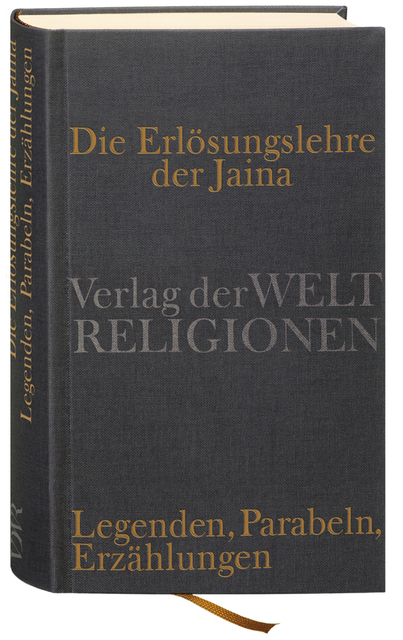 | Adelheid Mette: Die Erlösungslehre der Jaina - Legenden, Parabeln, Erzählungen (engl.: Jaina Soteriology. Legends, Parabels and Narratives). Berlin: Verlag der Weltreligionen im Inselverlag, 2010. |
Today Jainism has just a marginal position in the academical indology and it seems nearly forgotten that researching on Jainism has a long tradition in Germany. Beginning with Jacobi's studies and his translations of important Jaina texts, Jainism has been described no longer as a Buddhist heresy. Soon followed a number of scholars, namely e. g. Weber, Glasenapp, Schubring, Alsdorf and Bruhn, forming Jainology as an own field of study inside of indology. So the late Adelheid Mette must be mentioned in the same vein. Among the current Jaina experts these researches have been appreciated, but most of the German studies kept unknown, or the monographs were translated into English quite late. So e. g. Glasenapp's "Der Jainismus" was translated and published in English 1999 in Delhi. This was more than seven decades after the German edition, when Jaini's "The Jaina Path of Purification" already had become such a classic. Otherwise no foreign work about Jainism has ever been translated into German language. So the German readers had no chance to learn about this topic since the mentioned works were out of print for a long time. Only Glasenapp's introduction has been reprinted in 1964, but other publications are not available beyond specialized libraries. From there to the public Jainism kept unknown, even the rise of Buddhism in the western world didn't change this. The more it is remarkable that now a comprehensive treatise has been published in German language.
The publication by Adelheid Mette stands more in Glasenapp's generally understandable tradition than Schubring's academical style, which is less readable for non-indologists.
Merely by looking at the table of contents, certain initial conclusions can be made. On the surface it seems like a revised extension of an earlier published anthology by the same author, titled "Durch Entsagung zum Heil" (engl. By Renunciation to Salvation), Zürich 1991. But on closer examination the reader becomes aware of the aims of this study. While the previous treatise was, in a broader sense, just a collection of jaina tales, this new publication meets the requirement of an introduction into the Jainism, where the specific characteristic of this survey is attained by the use of translated original sources. The selection of the text passages shows the author's focus on the older Jainism, i. e. most sources are originally written in Prakrit. A few translated passages are taken from the editions by Ernst Leumann.
The text is composed of a main part (pp. 9-198), divided into five chapters (I-V), and a commentary (pp. 201ff.) including glossary and bibliography.
At the beginning the reader is introduced to the biography of the last Tīrthaṃkara Mahāvīra, preceded by the Namaskar-mantra. The following text passages mainly originate from the Kalpa-Sūtra portray the life of Mahāvīra to exemplify the equal biography of all 24 Tirthankaras; this is the first translation of the biographical Kalpa-Sūtra into German language. Some particular passages from other works are added including a few Sanskrit sources. Finally this chapter (I) is completed by some short explanations about the existence and character of soul in Jaina belief, taken from Daśavaikālika-Niryukti, Haribhadra's Samarāiccakahā and other sources. The theme of this last section is explored further in the next chapter (II).
Returning to the previous theme, the following second chapter (II) combines some narratives to examine the function of karma and soul in the circular flow of reincarnation. Most of these text passages were taken from the less known Kuvalayamālākathā by Uddyotana Sūri, dating from 700 Śaka (= "780 CE"), while other passages are from more familiar sources like Uttarādyayana Sūtra, Āvaśyaka-Cūrni, Bṛhatkalpa-Sūtra or the Vasudevahindi by Sanghadāsa. The selected texts vary from the common narratives (e. g. "Die drei seereisenden Kaufleute", engl.: "The Three Sailing Merchants") taken from Kuvalayamālā by Uddyotana Sūri (pp. 70ff.), up to some more particular parables about negative behavior like anger, pride, lie and greed (pp. 75ff.).
Then the third chapter (III) illustrates the road to salvation. It contains some parables about people of different social background, who change their bad and immoral behavior to find a way to deliverance according to the Jaina teachings. First the livings of two animated beings (jiva) of opposed character, bound by their karma in the flow of reincarnation are described (pp. 127ff.). The following tales are about asceticism. According to Jaina tradition, this was introduced to the eternal Jaina dharma by the last Tīrthaṃkara Mahāvīra as a reformation of the order (cf. pp. 336). The tales describe the type of bāla-tapasvin, which means an ascetic who practises mortification. However the translation of the term bāla into "töricht" (engl. "foolish") in a title (p. 131) is deceptive to the reader, but it is explained in the commentary notes (pp. 336f.). Finally some narratives describe spiritual awakening as the result of misfortune, which led the protagonist, who got astray, back to the right behavior. Again all these texts are from various sources, e. g. Samarāiccakahā by Haribhadra, Vyākhyāprajnapti, Vinayavijaya's Lokaprakāśa and the Viśeṣāvaśyaka commentary by Hemacandra Maladhārin.
Subsequently the fourth chapter (IV) concerns piety of the laymen and asceticism. Some passages from the Samarāiccakahā by Haribhadra include the correct conduct of Jaina laymen (pp. 149ff.), the ability of practicing asceticism (pp. 153f.) and the decision to renounce the world (pp. 154f.). A passage from the fourth chapter of Jnātādharmakathāḥ uses an allegory to describe the need of subjugating the senses (pp. 163ff.), a passage from the Daśavaikālika Sūtra introduces briefly the principles of the Jaina order (pp. 166ff.) while passages from other sources, including Uttarādhyayana Sūtra and Āvaśyaka records, are about humbleness, meditation and acting right.
Finally the last chapter (V) of the main part is titled "Vollendung" (engl.: Salvation). Some excerpts from Āvaśyaka records, Sūtrakŗtāṅga II, Aupapātika Sūtra and Haribhadra's Samarāiccakahā describe the Jaina conception of salvation. These narratives exemplify the different kinds to perform deliverance, controlled by the individual relation concerning karma and soul. Additionally some passages illustrate the Buddhist influence, especially the idea of salvation of the laymen by worship, or the deliverance of the ascetics by the sight or the presence of the Jina (pp. 184ff., cf. commentary pp. 376f.).
The commentary (pp. 201ff.) starts with a short introduction into Jainism (pp. 201-240); the reader without previous knowledge should be recommended to read this chapter first.
In a first part (pp. 202-209) the reader is introduced to the concept of twenty-four Jinas (pp. 202-204) and the mention of this term in the Ācārāṅga-Sūtra, which is probably the earliest Jaina source. According to some Buddhist sources, Siddhartha Gautama (the historical Buddha) identifies himself as a "Jina" too. So it is illustrated that this title described rather a person of outstanding attitude, namely the abandon of karma, than the founder of a religion on his own. Thus the basic difference between Buddhism and Jainism is revealed: compared to Buddhism, a founded religion, Jainas have never seen their religion as a new quest to salvation, founded by Mahāvīra or one of his ancestors. Instead the last Tīrthaṃkara is portrayed as a seeker of truth, standing in the tradition of a number of vedic ascetics (p. 202f.). So Jainism stands in the tradition of ancient Indian religion right from the beginning, while Buddhism forms an opposition. Closing this sequence the reader is introduced to the term "Arhat" in Jainism (p.203) including some notes to the Buddhist opposition.
The next sequence (pp. 204-209) portrays the five most famous Tīrthaṃkaras, i. e. Rsabha, Mallinātha, Neminātha, Pārśva and Mahāvīra. Here the annotations to Mahāvīra are of particular interest since this is a completion from the academical point of view to the preliminary biographic excerpts of Jaina tradition.
The followed second part (pp. 209-223) combines introductory notes on Jaina monachism, the formation of different traditions and doctrines, including modern sects, some general remarks on Jaina laymen, temples and ritual sites and the situation of Jainas in modern India.
The third part (pp. 223-232) treats the Jaina world view; the reader is now introduced to the cosmological belief and the traditional Jaina geography (this section is completed by some illustrations), while the last part (pp. 232-240) contains some concluding remarks on the eternal nature of soul in Jainism.
This brief outline of Jainism is followed by an extensive commentary (pp. 241-411) and a detailed glossary (pp. 412ff.). Finally the elaborate description of the illustrations (pp. 392ff.) is respectable.
The significance of this publication has been appreciated at the beginning of this paper. The German-speaking readership is indebted to the author to edit this important book in the German language.
It is desirable that this book meets universal approval and an additional translation into English.
 Dr. Patrick Krueger
Dr. Patrick Krueger